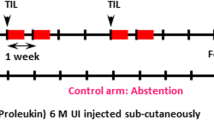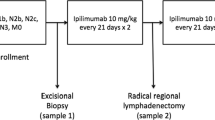Abstract
High-dose interferon alfa-2b (IFNα-2b) is the only approved adjuvant systemic therapy for resected, high risk melanoma in the United States (Fecher and Flaherty, in Natl Compr Cancer Netw 7:295–304, 2009). Recently, two important meta-analyses of randomized trials (Wheatley et al., in J Clin Oncol, 2007; Mocellin et al. in J Natl Cancer Inst, 2010) investigating IFNα-2b versus observation in high risk melanoma patients, showed that adjuvant IFNα-2b has an impact both on relapse-free survival (RFS) and overall survival (OS) independently by dosage, duration and route compared with observation in high risk melanoma patients. Despite of an absolute benefits of 3 % (Wheatley et al., in J Clin Oncol, 2007), this treatment is associated with significant toxicity, which impacts on patient quality of life. A better understanding of the mechanism of action may help to potentiate the clinical efficacy and reduce the toxicity of IFNα-2b/Peg-IFNα-2b. Numerous studies suggest that interferon’s mechanism of action in melanoma is primarily immunomodulatory (Table 1) (de La Salmoniere, in Clin Cancer Res 6:4713–4718, 2000; Stuckert, in J Clin Oncol 25:8506, 2007; Gogas et al., in N Engl J Med 354:709–718, 2006; Moschos et al., in J Clin Oncol 24:3164–3171, 2006; Ascierto and Kirkwood, in J Transl Med 6:62, 2008) Recent efforts to elucidate the mechanism of action for interferon have focused upon signal transducers and activators of transcription (STAT) (Simons et al., in J Transl Med 9:52, 2011) signaling and immunoregulatory responses mediated by regulatory T cells (Tregs) (Wang et al., in Clin Cancer Res 13:1523–1531, 2007; Clin Cancer Res 14:8314–8320, 2008). Tregs are a suppressive CD4+ T cell population that is present, along with primed effector T cells, in tumor and tumor-draining lymph nodes (Hiura et al. in J Immunol 175:5058–5066, 2005). Tregs express high levels of surface antigens such as CD25, cytotoxic T lymphocyte associated antigen 4 (CTLA-4), and glucocorticoid-induced tumor necrosis factor receptor (GITR) (Takahashi et al., in J Exp Med 192:303–310, 2000; Shimizu et al., in Nat Immunol 3:135–142, 2002). Moreover, Tregs express a characteristic nuclear transcription regulator, forkhead box P3 (FoxP3) (Hori et al., in Science 299:1057–1061, 2003; Gabriel and Lattime, in Clin Cancer Res 13:785–788, 2007). The presence of Tregs in tumor-draining lymph nodes and tumors provides a potential inhibitory population that may block or balance effector cell function. Thus, depletion of Tregs or blockade of Treg function using targeted antibodies or other strategies might be able to remove Treg suppression and enhance antitumor immunity (Viguier et al., in J Immunol 173:1444–1453, 2004). We conducted an observational study to examine whether the induction phase of the FDA-approved HDI regimen administered iv in patients with stage 3–4 melanoma (20 MU/m2 intravenously (IV) five times per week for 4 weeks) reduced the number of Treg cells in the peripheral blood.




Similar content being viewed by others
References
Fecher LA, Flaherty KT (2009) Where are we with adjuvant therapy of stage III and IV melanoma in 2009? J Natl Compr Cancer Netw 7:295–304
Wheatley K, Ives N, Eggermont A, et al. (2007) Interferon-α as adjuvant therapy for melanoma: an individual patient data meta-analysis of randomised trials. J Clin Oncol. ASCO annual meeting proceedings Part I 25: Abstract 8526, 2007 (18S (June 20 Supplement))
Mocellin S, Pasquali S, Rossi CR, et al. (2010) Interferon alpha adjuvant therapy in patients with high-risk melanoma: a systematic review and meta-analysis. J Natl Cancer Inst
de La Salmoniere P, Grob JJ, Dreno B et al (2000) White blood cell count: a prognostic factor and possible subset indicator of optimal treatment with low-dose adjuvant interferon in primary melanoma. Clin Cancer Res 6:4713–4718
Stuckert JJ II, Tarhini AA, Lee S, et al (2007) Interferon alfa-induced autoimmunity and serum S100 levels as predictive and prognostic biomarkers in high-risk melanoma in the ECOG-intergroup phase II trial E2696. J Clin Oncol (Meet Abstr) 25:8506
Gogas H, Ioannovich J, Dafni U et al (2006) Prognostic significance of autoimmunity during treatment of melanoma with interferon. N Engl J Med 354:709–718
Moschos SJ, Edington HD, Land SR et al (2006) Neoadjuvant treatment of regional stage IIIB melanoma with high-dose interferon alfa-2b induces objective tumor regression in association with modulation of tumor infiltrating host cellular immune responses. J Clin Oncol 24:3164–3171
Ascierto PA, Kirkwood JM (2008) Adjuvant therapy of melanoma with interferon: lessons of the past decade. J Transl Med 6:62
Simons DL, Lee G, Kirkwood JM et al (2011) Interferon signaling patterns in peripheral blood lymphocytes may predict clinical outcome after high-dose interferon therapy in melanoma patients. J Transl Med 9:52
Wang W, Edington HD, Rao UN et al (2007) Modulation of signal transducers and activators of transcription 1 and 3 signaling in melanoma by high-dose IFNalpha2b. Clin Cancer Res 13:1523–1531
Wang W, Edington HD, Rao UN et al (2008) Effects of high-dose IFNalpha2b on regional lymph node metastases of human melanoma: modulation of STAT5, FOXP3, and IL-17. Clin Cancer Res 14:8314–8320
Hiura T, Kagamu H, Miura S et al (2005) Both regulatory T cells and antitumor effector T cells are primed in the same draining lymph nodes during tumor progression. J Immunol 175:5058–5066
Takahashi T, Tagami T, Yamazaki S et al (2000) Immunologic self-tolerance maintained by CD25+ CD4+ regulatory T cells constitutively expressing cytotoxic T lymphocyte-associated antigen 4. J Exp Med 192:303–310
Shimizu J, Yamazaki S, Takahashi T et al (2002) Stimulation of CD25+ CD4+ regulatory T cells through GITR breaks immunological self-tolerance. Nat Immunol 3:135–142
Hori S, Nomura T, Sakaguchi S (2003) Control of regulatory T cell development by the transcription factor Foxp3. Science 299:1057–1061
Gabriel EM, Lattime EC (2007) Anti-CTL-associated antigen 4: are regulatory T cells a target? Clin Cancer Res 13:785–788
Viguier M, Lemaitre F, Verola O et al (2004) Foxp3 expressing CD4+ CD25(high) regulatory T cells are overrepresented in human metastatic melanoma lymph nodes and inhibit the function of infiltrating T cells. J Immunol 173:1444–1453
Author information
Authors and Affiliations
Corresponding author
Rights and permissions
About this article
Cite this article
Mozzillo, N., Ascierto, P. Reduction of circulating regulatory T cells by intravenous high-dose interferon alfa-2b treatment in melanoma patients. Clin Exp Metastasis 29, 801–805 (2012). https://doi.org/10.1007/s10585-012-9504-2
Received:
Accepted:
Published:
Issue Date:
DOI: https://doi.org/10.1007/s10585-012-9504-2




